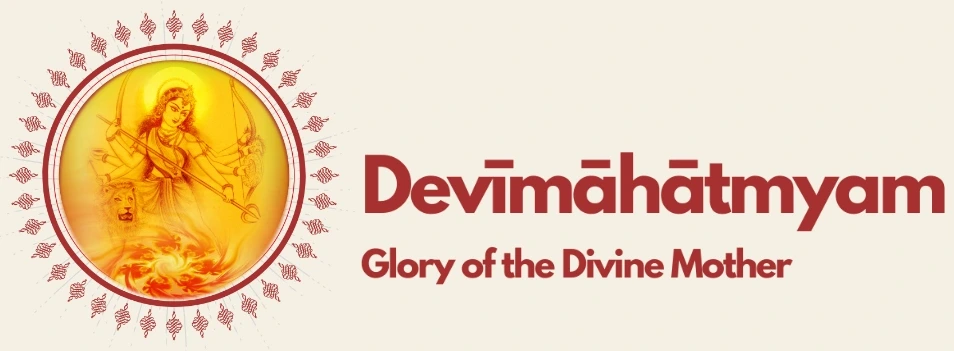Devī Sūktam-Text
In the thirteenth chapter it is said that the King and the Vaisya in order to see the Mother face to face did Tapas, reciting the great Devī Sūkta, Devī sūktam param japan. Which is the Devī Sūkta referred to?
Some would hold that the laud in the fifth chapter commencing namo devyai mahā devyai is the Devī Sūkta. But it is the considered opinion of many that the famous Devī Sūkta in the Ṛgveda is the one referred to here.
The Vedas are held as the authority and always an attempt is made to trace all the spiritual practices and religious rituals prevalent to the primary source of the Vedas. The Tantra pursues the Vedic teaching perhaps from a different angle altogether but it always holds the Veda in great respect. Considering the unique place occupied by this text Saptaśati in Tantric literature and its occult practices, it is quite natural to seek for something explicit or implicit in the Vedic wisdom setting its seal of approval on this Sādhāna. It is true that the story, ritual or mode of worship mentioned in Saptaśati does not find a place in Ṛgveda. But if we study carefully the Devī Sūkta, the 125th hymn in the tenth Maṇḍala of the Ṛgveda and delve into its thought, we find that for the first time the glory of the Goddess, Devi Māhātmya is delineated here. Thought, spirit and Mantra - force vie with one another squandering the wealth of the Divine Afflatus through the words of Ambhṛṇi Vāk. The seer of the hymn is a Ṛṣikā, the daughter of Ambhṛṇa and her name itself is Vāk. She expresses the Divine Glory revealed to her through the inspired word in the form of this hymn. There are many hymns in the tenth Maṇḍala where the name of the seer and the name of the deity he sees are one and the same. The reason is that the seer is one with the godhead he sees in himself completely identified and as a result the name of the godhead becomes also his name. Likewise in this hymn the name of the Ṛṣikā and the name of the deity are one and the same, viz. Vāk, because the daughter of Ambhṛṇa realises in her the creative Word, the primary Nāda, the Parā śakti of the Tantra, becomes that and expresses herself through this hymn. “It will be more correct to say that the Female Energy of the Supreme Godhead para-devatā realising herself in or choosing the embodiment of Vāk Ambhṛṇi utters the Word, the Mantra.”
1. Further Lights: The Veda and the Tantra by Kapali Sastriar
Even a cursory reading of the hymn will bring home to the reader the glory of the Goddess. In the Devī Māhātmya, Mahālakṣmī is mentioned as the primordeal Prakṛti made up of the three qualities, sattva, rajas and tamas and from her manifest Mahākāli and Mahāsarasvatī. This will be clear when one reads the Rahasya-traya. The middle episode describes how this Mahālakṣmī came into being. Though she is the Prime Mover, the Śaktis of all the gods joined together to make her as the Parā śakti. This important concept of the Devī Māhātmya is portrayed in the phrase tam mā devā vyadadhuḥ, in the third Rik of the Devī Sūkta. The immanent form of the Goddess described in a series of verses beginning with yā devi sarvabhuteṣu is explained in the fourth Rik mayā so annam atti. In the declaration of Vāk in the fifth Rik it is said that whomsoever she loves, she makes him mighty, him a Brahman, him a Ṛṣi, him a man of pure under- standing, tam ṛṣim tam sumedhām. Can it be an accidental coincidence that it is Ṛṣi Sumedha who narrates the glory of the Goddess to the monarch and the merchant? The cardinal doctrine of the Saptaśati that the Goddees takes birth to protect the worlds and slay the wicked, we find already proclaimed in the sixth Rik of Devī Sūkta, Aham rudrāya dhanuratānomi brahmadviṣe śarave hantavā u. The universal and trancendental form of the Divine Mother is expressed in the last line paro divā para enā pṛthivyai tāvati mahinā sambabhūva. What is thus expressed directly in the Veda is portrayed with epic grandeur in the striking verses of Saptaśati.
“The tread of her feet bent the earth low, the top of her crown scraped the welkin high. With the twang of her bow string, she shook the entire nether - world and with a thousand arms, she stood covering all the quarters.” (II.38.39)
Thus, we find a close correlation between the sum and substance of Devī Māhātmya and the Devī Sūkta in the Ṛgveda. And on the strength of the phrase devī suktam param japan, found in the thirteenth chapter, we can conclude that the recital of the Devī Sukta in the Ṛgveda has been a part of Chaṇḍi worship and the Vedic basis of Devī Māhātmyam has to be found in this Devī Sūkta of Vāk Ambhṛṇi.

